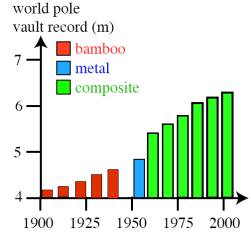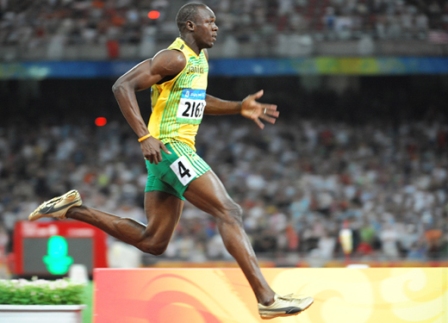The 2008 Beijing Olympics saw its fair share of history when an astounding 43 world records were broken. This would seem like a staggering number, except when you look at the fact that another 37 more records were broken at the 2012 in London, some of which were set just 4 years prior at Beijing. This trend has been going on steadily since the establishment of the the games, and will continue to happen, but why? Many scientists have claimed that humans have “butted up against the limits of human athletic capabilities”, yet “records continue to fall”. Clearly there are factors outside of raw potential and capability that are playing a role in the performance of Olympic athletes.
The most commonly cited component influencing the outcome of an athletes performance (aside from their abilities) is the continuous improvement of athletic related technology. As technology improves, many aspects of a society also see improvement, and athletics have not been an exception. From “improved starting blocks” to a change in the “composite fibers” of  badminton rackets, every sport has been “dramatically touched by technology” Many surges in record breaking can be explained when comparing the technology of then and now. For example, the Tokyo Olympic games came with the unveiling of an improved pole vault, which was now “made out of fiberglass, rather than aluminum (which at one point replaced bamboo)” Both of these materials changes resulted in a more “flexible” pole vault, which meant the vaulters saw a greater “translation of energy between their run-up and vault”. Subsequently, the years of the debut for both material changes saw a drastic increase in the standing record, and “ripple records” in the coming games, as the athletes became more familiar with the equipment.
badminton rackets, every sport has been “dramatically touched by technology” Many surges in record breaking can be explained when comparing the technology of then and now. For example, the Tokyo Olympic games came with the unveiling of an improved pole vault, which was now “made out of fiberglass, rather than aluminum (which at one point replaced bamboo)” Both of these materials changes resulted in a more “flexible” pole vault, which meant the vaulters saw a greater “translation of energy between their run-up and vault”. Subsequently, the years of the debut for both material changes saw a drastic increase in the standing record, and “ripple records” in the coming games, as the athletes became more familiar with the equipment.
One of the most popular and relevant influences that technology has played in record-breaking was the introduction of the full body “polyurethane swimsuit” in the 2008 Beijing games. The swimsuits “acted as extremely tight girdles” by “compressing the swimmer’s muscles” and in  turn reducing “friction from the water”. The suits proved effective, as 25 records were broken that year in swimming alone, the most since 1976 which was uncoincidentally the time when swimming goggles were first used in the Olympics. The full body suits were so effective that they were banned for competitive use (although the records stand) by the Olympic Committee, because they were too concerned about “technology’s influence on record breaking”. Technological and scientific advancements are evident every 4 years, and encompass much more than athletic gear. Better technology means “more effective training”, and a better understanding of the human body has resulted in “better training programs, nutrition, and recovery”.
turn reducing “friction from the water”. The suits proved effective, as 25 records were broken that year in swimming alone, the most since 1976 which was uncoincidentally the time when swimming goggles were first used in the Olympics. The full body suits were so effective that they were banned for competitive use (although the records stand) by the Olympic Committee, because they were too concerned about “technology’s influence on record breaking”. Technological and scientific advancements are evident every 4 years, and encompass much more than athletic gear. Better technology means “more effective training”, and a better understanding of the human body has resulted in “better training programs, nutrition, and recovery”.
Not only has technology improved performance output, it has also lead to developments in the quality of living around the world, which has allowed more people to take part in athletics. This as well as a growing population means that the chances of a more genetically superb athlete to arise grow more and more every 4 years.
Although technology and science have a very high ceiling, scientists have concluded that human abilities such as running, jumping, and swimming have maximum potentials that can not be surpassed. Olympic sprinters such as Usain Bolt (who currently holds the 100m dash record)  apply forces of around “800 to 1000 pounds with just a single limb”. Experiments conducted on a treadmill found that this force is not what limits humans however, and that humans could “handle much greater force”. The factor that was concluded to be the limiting factor with running (as well as other physical acts) is “time”. Study’s comparing forward and backward running suggest that their is a “physical limit at which the muscle fibers can work to get your feet off the ground” This means that maximum capabilities can be calculated by the “contractile muscle fibers”, and the maximum speed of a human was calculated to be about “35-40” mph, compared to Usain Bolt, who can run 28 mph.
apply forces of around “800 to 1000 pounds with just a single limb”. Experiments conducted on a treadmill found that this force is not what limits humans however, and that humans could “handle much greater force”. The factor that was concluded to be the limiting factor with running (as well as other physical acts) is “time”. Study’s comparing forward and backward running suggest that their is a “physical limit at which the muscle fibers can work to get your feet off the ground” This means that maximum capabilities can be calculated by the “contractile muscle fibers”, and the maximum speed of a human was calculated to be about “35-40” mph, compared to Usain Bolt, who can run 28 mph.
These experiments and calculations mean that the athleticism of human’s has a maximum. The maximum has not yet been reached. On top of that, technological advances have contributed to a trend of constantly broken records. Humans will continue to train harder and harder and push the ceiling of their athleticism as technology and science run parallel, and records will continue to be set. However, humans may eventually reach their maximum capabilities, and protest from the community may lead to an effort to keep technology out of the games to preserve records (as seen with the polyurethane suit) and records may cease to be broken, or the pace of record setting may slow drastically.

I have never actually thought of this but now that you brought it up it is a very interesting topic. There must come a time when records can’t be broken anymore but by the way it looks more and more records are being broken each Olympic year. As technology increases like you said it becomes easier to break records however, I think there will eventually come a time when it becomes nearly impossible for athletes to continue to break records.
I often wonder about this as well. I am very into watching the Olympics, and it astonishes me how often records are broken. I swam throughout high school, and watching teammates and people from other schools always fascinated me. Someone on my team, broke every single record on our high school swim team and was in my graduating class. Swimming with him was cool and exciting to watch. I am glad you included the part about suits, because most people don’t know that Speedo designed a suit that was “too fast” to use in competitions. And it was crazy to see that records set in these suits were still able to be broken. I think a big reason why records will always continue to be broken is training and technology. Technology allows us to train better, and better monitor what we should be doing. For example, my one coach went to Olympic Trials in 2008. The US Swim Team, who mainly made up the Olympic Swim Team, all had blood work tests done to ensure their chemical balances were even and where they should be after their warmup. My coach was at a disadvantage because she did not have the available means to blood test to check the efficiency of her warm down. For training, my high school swim team has developed a much better weights program than we had freshman year. And while my swimming certainly improved because of my age, knowledge of strokes, and skill level, a big part of my success is due to our weight training and knowing how to improve our strength. That is just at a high school level. The US Swim Team has trainers and scientists dedicated to making their athletes’ bodies the best they can possibly be. Swim suits have always been a constant improvement, assisting the swimmer by going faster and finding better ways to effectively compress their muscles to save energy. I have experienced a lot of this first hand and I truly do think humans will continue to break records, and improve. There will be a point in time where things are impossible and people reach a limit (no one will be able to swim 50 meters in 5 seconds), but I don’t think we are anywhere close to that limit thanks to always improving training, science, dieting, and so many other variables.